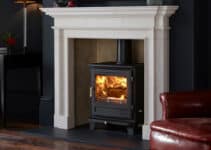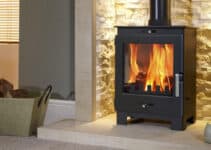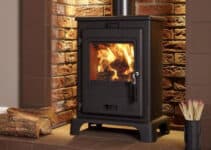When undertaking the installation of a log burner, one of the most pressing inquiries I often encounter pertains to flue location – specifically, the recommended log burner flue distance from a window. With flue safety being a significant consideration, my focus has always been to uphold the highest standards. There’s a delicate balance to strike between ensuring optimal performance and adhering to safety protocols. My aim is to guide through the subtleties of log burner flue placement recommendations, drawing from professional experiences and established safety norms.
Through a refined understanding of best practices, I’ve come across various perspectives on this matter. However, experience has solidified that maintaining a prudent clearance from windows is imperative to circumvent potential perils such as glass damage due to thermal shock, particularly in chillier climes. In this discourse, I seek to elucidate the importance of a secure distance, factoring in actual user experiences from respected forums where variances in acceptable clearances have been observed. My aim is to comprehensively explore this topic and furnish a depth of insight into flue safety for those considering installing a log burner at home.
Understanding Log Burner Flue Regulations
As a homeowner considering the installation of a log burner, it’s paramount for me to thoroughly understand the log burner flue regulations. These regulations are put in place not merely as guidelines, but as essential measures to ensure the safety and well-being of residents and their property. Compliance with such directives ensures that the high temperatures and potential hazards posed by log burners are carefully managed.
Importance of Adhering to Safety Standards
It’s my responsibility to ensure that each step of the log burner flue installation conforms to local building codes and safety standards. The main purpose of such rigour is to prevent accidentals fires and minimise the risk of property damage. This is particularly crucial for features such as double-glazed windows which are susceptible to the phenomenon of thermal shock, especially in areas with low temperatures.
Key Considerations for Flue Placement
Plenty of factors come into play when determining the appropriate logistics of flue placement. To start with, factors such as the size of the stove, its heat output, and the dimensions of the room in question are fundamental. These variables contribute to creating tailored clearances which can then be adjusted to suit very particular circumstances. To ensure I adhere to the log burner flue installation guidelines, enlisting the services of a professional for installation is beneficial. They can navigate the complex landscape of non-combustible clearance regulations, which are critical for maintaining a safe proximity to windows and other materials that could potentially combust.
In the spirit of maintaining the highest possible safety standards and following stringent log burner flue requirements, I will continue to delve into the specifics of the relevant building regulations. The expertise and guidance of certified installers will also play a crucial role in ensuring my home aligns with recognised safety protocols.
Minimum Distance Requirements for Log Burner Flues
As a professional in the field, I cannot overemphasise the significance of adhering to log burner flue clearance guidelines. It is not merely a matter of formality; these regulations are crafted with utmost safety considerations in mind. The building codes, which often lay down these recommendations, speak with the voice of accumulated expertise, seeking to preclude any safety hazards associated with wood stoves and their flues in domestic environments.
The heat generated by a log burner is palpable and substantial, making it imperative to respect the log burner flue distance guidelines from windows, which are especially susceptible to damage. I have personally observed the benefits of maintaining the standard clearance of 36 inches from windows, which has effectively averted overheating and subsequent damage to the glass panes. Yet, flexibility within the rules does exist. For specific scenarios and stove sizes, some building codes allow a reduced clearance, which might go down to 12 inches, although this is context-dependent and should not be generalised.
| Type of Stove | Minimum Recommended Clearance | Possible Reduced Clearance | Rationale for Clearance |
|---|---|---|---|
| Small Wood Stove | 36 inches | Not recommended | Prevents glass overheating |
| Large Wood Stove | 36 inches or more | 12 inches (rarely advised) | Mitigates risk of high heat exposure |
| Pellet Stove | 36 inches | May vary based on pellet type used | Ensures adequate heat dispersion |
Let me underscore that a large wood stove, which can hold more fuel and achieve higher temperatures, will indeed necessitate larger clearances. This is to prevent the intense heat produced from becoming a fire hazard or causing damage to the windows or any other nearby combustible materials. The concept here is straightforward: the greater the heat output, the more substantial the safe clearance distance must be.
In conclusion, while there is a minimum standard for safe distances, comprehensive consideration of individual circumstances and stove types is essential for determining the right flue clearance. Professional assessments often take into account the specific features of the stove, the positioning of surrounding windows, and the unique characteristics of the building itself, ensuring every installation maintains the highest safety standards.
How Far Does a Log Burner Flue Need to Be from a Window
As a homeowner or installer, my focus is inevitably drawn to the crucial question of log burner flue proximity to a window. Understanding that safety and compliance are paramount, I scrutinise the many factors that influence this spacing. It’s widely stated that a 36-inch buffer is recommended to avert any damage that could be inflicted upon the windows. Despite the acknowledgement of such clearances, I must also consider various conditions that could modify these guidelines.
Recognising the differences in window construction – particularly tempered glass known for its hearty resistance against heat as opposed to standard glass – permits a level of flexibility with distance requirements. The dimensions of the room itself also play a critical role; larger spaces may be more forgiving, allowing for a wood stove to be situated closer to a window without breaching safety norms.
One must never overlook the impact of external elements such as wind direction, which can affect how heat distributes from a wood stove’s flue. Now, let me present you with a table detailing some key factors affecting the ideal spacing for your log burner flue relative to a window:
| Factor | Consideration | Advised Distance |
|---|---|---|
| Type of Glass | Standard Glass: High vulnerability to heat Tempered Glass: Better heat resistance |
Standard: Minimum 36 inches Tempered: Potentially less |
| Room Size | Smaller Room: Requires greater clearance Larger Room: May allow reduced clearance |
Varies based on stove heat output and room volume |
| External Factors | Wind direction can affect heat transfer | Adjust distance to account for potential increased heat exposure |
When positioning a log burner, it’s vital to acknowledge that proximity to a window extends beyond adhering to standards; it’s inherently tied to the safety and comfort within the home. My exercise as an installer is to meld these insights with existing safety regulations to cultivate an environment that is both warm and secure.
The Relationship Between Flue Proximity and Window Safety
Understanding the interplay between log burner flue placement and the safety of nearby windows is not a matter of aesthetics alone, but is a critical component of home safety. Log burner flue regulations are established to foster both security and efficiency within a dwelling. My insights today focus on the essentiality of adhering to these regulations to ensure optimal log burner flue safety.
Potential Risks of Incorrect Flue Placement
The repercussions of not following log burner flue placement recommendations can be quite severe, ranging from minor damage to significant hazards. The incidences of thermal damage are notable, with glass panes being especially susceptible to cracking or even shattering under consistent heat pressure. Yet beyond the glass, nearby furnishings and structural elements could also suffer, potentially catching fire if flue placement is too proximal.
Case Studies: Real-Life Incidents and Precautionary Tales
In my journey to uncover the truths behind flue placement, I’ve encountered compelling stories from individuals who have experienced the consequences first-hand. While warranties might provide some solace, they frequently do not cover the costs of damages borne from installation oversight. Such tales iterate the indispensable nature of rigorous adherence to safety guidelines.
| Inadequate Placement | Resultant Damage | Preventive Action |
|---|---|---|
| Flue too close to window | Full-length window crack | Maintain recommended safety distance |
| Improper materials used | Increased fire risk | Use heat-resistant, non-combustible materials |
| Lack of regular maintenance | Deteriorated flue integrity | Engage in routine flue inspections |
In conclusion, it is clear that the careful placement of log burners and their flues in relation to windows is pivotal, not just for compliance but for the enduring safety and integrity of one’s home.
Professional Recommendations for Log Burner Flue Installation
As a copywriting journalist focused on offering valuable insight into home improvements, I’m here to discuss the log burner flue installation guidelines and log burner flue requirements as advised by leading industry experts. These professionals underscore the necessity to observe specific protocols for both safety and efficiency.
The installation of a log burner flue system should never be a casual decision, given the implications it bears on the wellbeing of my readers and their homes. Respected authorities in the field agree that several measures are imperative for appropriate log burner flue positioning, especially to avoid heat-induced damage to nearby windows.
It is universally endorsed that log burner flues be placed at a considerable distance from windows, ensuring a safeguard against the heightened risks tied to heat exposure.
Apart from mere placement nuances, I’ve learned that regular inspections of stovepipes and chimneys are not just recommended; they are crucial. The presence of a carbon monoxide detector within close proximity to the wood stove is another non-negotiable safety feature. I am convinced that these practices are not just guidelines; they are a lifeline in effective stove management.
- Trained professional installation
- Routine inspections of flue and chimney
- Carbon monoxide detector installation
- Selection of appropriate chimney types
- Proper orientation and simplicity in ventilation systems
- Choosing quality fuel for burning
For a clearer understanding, consider this detailed table I’ve compiled based on expert recommendations:
| Installation Factor | Details | Expert Tips |
|---|---|---|
| Flue-Chimney Distance | Safe distance from windows and other combustible materials | Maintain a minimum distance as per safety standards; consult local building codes |
| Inspections | Routine pre-use checks | Annual professional inspection advised; check for obstructions and wear |
| Carbon Monoxide Safety | Installation of detectors | Place detectors near the wood stove and sleeping areas; test regularly |
| Ventilation System | Correct orientation and design | Ensure easy channeling of heat and smoke; avoid complex system designs |
| Fuel Quality | Type of fuel used | Use only recommended quality fuel; avoid green or moist wood |
The information disseminated here revolves around creating an environment that respects the fire dynamics, a factor that’s often overlooked by homeowners. Insurers also appreciate these efforts to minimise risks, which helps in maintaining policy integrity. This table, along with the insights I’ve gathered, emphasises the importance of a rigorous process when installing a log burner flue system.
To conclude, the safety of a home and its occupants depends heavily on the proper installation of a log burner flue. By following these professional guidelines and understanding the nuance of installation demands in diverse conditions, my audience can enjoy the benefits of a log burner with peace of mind.
Log Burner Flue Clearance and Home Insurance Implications
As a homeowner mindful of both safety and compliance, I hold in high regard the significance of log burner flue distance from window — a metric that cannot be underestimated in relation to home insurance implications. A thorough understanding of the intricate relationship between log burner flue regulations and insurance policies ensures that not a detail is overlooked in maintaining a secure and insurance-compliant home environment.
How Flue Distance Can Affect Insurance Policies
It’s well established that insurance companies meticulously assess risk factors when issuing policies, especially those addressing fire hazards within residential properties. Log burner flue clearance is often scrutinised, for the proximity of a log burner to windows is regarded as a substantial risk, with the potential for significant consequences if not addressed correctly. Failing to comply with the stipulated log burner flue regulations does not merely elevate the likelihood of damage but may also lead to the nullification of insurance coverage, should an unfortunate event stem from non-compliance.
Preventing Costly Damages and Claims
To sidestep the undesirable repercussions of such events, fostering a proactive approach towards log burner installation and maintenance is vital. By observing the recommended log burner flue clearance from windows, one not only safeguards against the physical damage to window panes but also mitigates the risk of costly claims that can arise from non-adherence. Insurance agencies advocate for this very reason, promoting a culture of diligence that actively prevents risk and enhances the longevity and safety of our homes.
In conclusion, as we address the dual objective of maintaining the window’s integrity and ensuring adherence to insurance requirements, it is the meticulous observance of proper installation protocols and regulations that emerges as a cornerstone of responsible homeownership. It is with this knowledge and practice that we secure not just our property, but also the peace of mind that stems from a compliant and well-protected home.
Avoiding Thermal Shock: Recognising Window Vulnerabilities
As we delve into the intricacies of safeguarding our homes with the warmth of a log burner, it is imperative to understand the susceptibility of windows to thermal shock. This phenomenon, which can cause windows to crack or even shatter, is not merely a cautionary note but a pressing concern. Thermal shock occurs when there is a rapid change in temperature, a scenario easily envisioned with a log burner flue too close to a window. The very safety of our households hinges on our recognition of this danger and the proactive measures we take to mitigate it.
The Science of Window Reactivity to Heat
Deciphering the science of window reactivity to heat is fundamental to maintaining log burner flue safety. Common window glass, though seemingly robust, is fraught with limitations in thermal tolerance. Contrasting this, we have tempered glass, designed to withstand greater thermal variances. Yet, irrespective of the glass type, respecting log burner flue distance guidelines is non-negotiable for preventing damage. It’s the understanding of these material thresholds that informs our installation strategies, ensuring the longevity of our windows.
Mitigating the Risks of Thermal Stress on Windows
I cannot emphasise enough the importance of meticulously planning the placement of your log burner flue. Taking into account the stove’s heat output, room geography, and thermal distribution is vital for mitigating the risk of thermal stress on windows. My advice is unwavering in advocating for adherence to set log burner flue distance guidelines. This foresight allows us to equip our homes against the threats of thermal shock, ensuring that our serene winter scenes remain uninterrupted by the sharp retort of fracturing glass.


